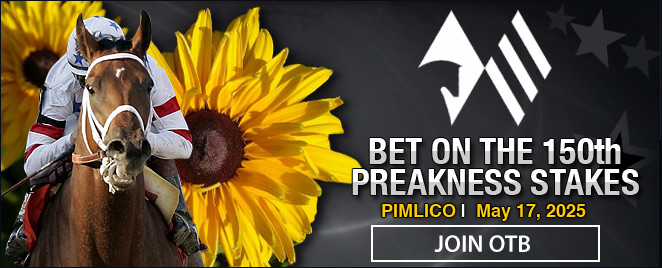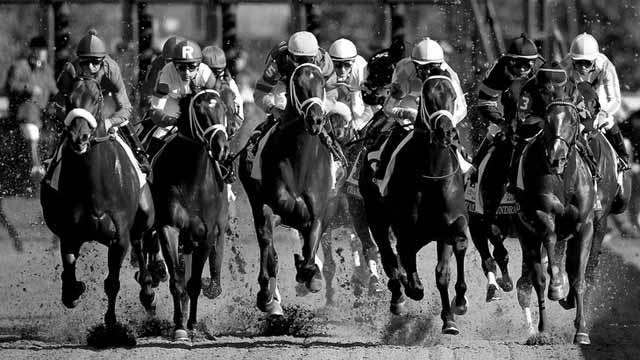Preakness Stakes Traditions
When is the Preakness Stakes?
The Preakness Stakes is on Saturday, May 17, 2025
Where is the Preakness Stakes?
The Preakness Stakes is raced at Pimlico Racecourse in Baltimore, Maryland
Where can I watch the Preakness Stakes?
Watch the Preakness Stakes live on TV with NBC at 5:00 p.m. Eastern Time
The 150th running of the $1,500,000 Preakness Stakes (Grade I), is the second jewel of the Triple Crown, set for Saturday, May 17, 2025 at historic Pimlico Race Course in Baltimore, Maryland.
Pimlico Weather Vane
The Kentucky Derby has "My Old Kentucky Home;" the Preakness Stakes has "Maryland, My Maryland." The Kentucky Derby has the blanket of roses; the Preakness Stakes has the blanket of black-eyed susans. But one thing the Preakness Stakes has that the Derby does not is the famed and historic weather vane that sits atop the Pimlico clubhouse cupola, a Preakness tradition since 1909.
As soon as the race winner is official, a painter climbs to the top of the structure and immediately repaints the horse and rider on the weather vane to reflect the colors of the winning jockey's silks. The original cupola was destroyed by a fire in 1966, but a replica has been constructed to enable the tradition to continue.
Here, in the words of the official Preakness site, is a description of this tradition: "As soon as the Preakness winner has been declared official, a painter climbs a ladder to the top of a replica of the Old Clubhouse cupola. He applies the colors of the victorious owner's silks on the jockey and horse which are part of the weather vane atop the infield structure."
Back in 1909 a horse and rider weather vane sat at the top of the old Members' Clubhouse, which was constructed at the opening of Pimlico in 1870. That building was destroyed by fire in June 1966, and a replica of the old building's cupola (a small structure on top of a roof or building) was built to stand in the Preakness winner's circle in the infield.
Originally the building had an arrow-shaped weather vane, but that one was destroyed by lightning in 1909. To replace it, the Maryland Jockey Club "commissioned an ornamental iron worker to forge a vane in the form of a horse and a rider. It was christened that spring by coating it with the colors of the silks borne by Effendi, winner of the 1909 Preakness.'
When the old Members' Clubhouse burned down the only thing saved was the iron weather vane, which was then put away for safekeeping at Pimlico as a memento. Since 1988 Lawrence Jones, who lives in the Pimlico neighborhood, has had the job of keeping the weather vane up-to-date. Past weather vane painter Michael Willinger had this to say about the famous contract work: "It is just the thrill of being able to participate in a big local and national event like this. Let's face it: it's the only televised sign painting job in the country." How true. How The Preakness Stakes Was Named.
Like a lot of names throughout America, the name Preakness is derived from Native American culture. A northern New Jersey band of Indians called the Minisi labeled their area Pra-qua-les, meaning "quail woods." After some inventive respellings, the name evolved into Preakness.
One variation of the name was Preckiness, used by General George Washington to describe where his troops were stationed during the 1776-77 winter. Milton Sanford, who we saw earlier in connection with the Dinner Party Stakes, called his farms (he had one in New Jersey and one in Kentucky) Preakness. Oddly enough, his New Jersey farm was located in the Indians' "quail woods," and there remains today a Preakness, New Jersey. Sanford, without much regard, purchased a yearling that was bred in Kentucky's Woodburn Farm, the eighth foal of a horse named Bay Leaf, for $2,000. He named it Preakness. Needless to say, it was this horse that as a three-year old went on to win the Dinner Party Stakes at Pimlico's inaugural in 1870. That was the horses only race of 1870, although he did continue to race through his eight-year old season, even winning races at that age.
In 1873, the Maryland Jockey Club honored him by calling its newest stakes race "Preakness," while the Dinner Party Stakes evolved into the present-day Dixie Handicap. After his eighth year of racing Sanford sent Preakness to England, where he was eventually purchased by the Duke of Hamilton. Yet like most of us, Preakness developed a temper in old age and became tough to handle. But unlike most of us, Preakness was shot and killed by his owner the Duke of Hamilton, who apparently had also grown a tad irritable. So, the legacy of Preakness is twofold: one, he supplied the name for the second jewel of the Triple Crown, and two, he touched off a reform in English law which governed the handling of animals. What a champion.
Woodlawn Vase
Created by Tiffany and Company in 1860 as a trophy for the now defunct Woodlawn Racing Association, the Woodlawn Vase is presented each year to the winning Preakness owner. An assessment in 1983 of $1 million easily makes its silver design the most valuable trophy in American sports. Until 1953, winners were awarded possession of the vase until the following Preakness.
That all changed when A. G. Vanderbilt's Native Dancer won it but his wife did not want to take on the immense responsibility of the vase's safekeeping. Now the winning owner is awarded a $30,000 sterling replica on a permanent basis while the perpetual is on display at The Baltimore Museum of Art and brought to Pimlico under guard for the annual running of the Preakness.
Black-Eyed Susan Blanket
It remains a long-standing tradition to present the winner of the Preakness a blanket of Black-Eyed Susans, which is draped across the shoulders of the winning horse. Colonel Edward R. Bradley's Bimelech in 1940 was the first winner to wear the floral blanket of Black-Eyed Susans. Construction of the blanket has varied in method from a loosely intertwined garland of flowers tied with hemp rope, to the current blanket type of presentation.
The Black-Eyed Susan blanket is created shortly before Preakness Day. It takes about eight hours for four people to make the blanket. The first step is to cut out a piece of black matting and a piece of green felt into the form of a blanket. The matting is spread out and Ruscus is placed on top.
Two people are assigned the duty of cutting Viking Poms about an inch from the flower and inserting a wire into the stem. The second pair of workers attach each flower through the matting by poking a wire through the flower to secure it into position. This process is repeated 4,000 times until the matting is completely covered. Then the green felt is sewn by hand to the back of the matting so that the wires are protected from touching the horse and so that the blanket will lay softly on the winner's withers.
The blanket is 18 inches wide and 90 inches in length. Upon completion, the center of the daisies are daubed with black lacquer to recreate the appearance of a Black-Eyed Susan. The blanket is then sprayed with water and refrigerated until Preakness Day, when it is delivered to the track, to be worn by the Preakness winner.
Black-Eyed Susans, declared the state flower by the Maryland legislature in 1918 and the Preakness flower in 1940, do not bloom until June in Maryland. It is said the Susan's flower usually has 13 petals, which is taken to symbolize the 13 original colonies, of which Maryland was one. The flower reproduces the state's black and yellow colors.
Preakness Stakes Song - Maryland, My Maryland
Like the other Triple Crown races, there are several long running traditions associated with the Preakness. Much in the same way that the Kentucky Derby is famous for the singing of `My Old Kentucky Home' before the race, the Pimlico crowd joins in the singing of "Maryland, My Maryland" which is usually performed by the United States Naval Academy Glee Club.
2025 Preakness Stakes Info
Use the links below to learn more about the second leg of the `Triple Crown of Horse Racing'
- 2025 Preakness Contenders - List & analysis of the 150th Preakness Stakes entries
- Preakness Past Winners - Listing of previous Preakness Stakes winners from 1873 until present.
- Betting the Preakness Stakes - There are several concepts unique to the race that have to be taken into account when handicapping the second leg of horse racing's Triple Crown.
- Preakness Stakes History - Notable Moments In Preakness History.
- Preakness Stakes Traditions - Listing of the long lasting honored traditions of the Preakness Stakes.
- Pimlico - Pimlico Racecourse is the annual host racetrack of the Preakness Stakes.
- Preakness Song Lyrics - Lyrics for Preakness Stakes song - Maryland, My Maryland
- 2024 Preakness Stakes Video Replay - Seize The Grey Wins Preakness Stakes at Pimlico.
- Horse Betting News - Get up-to-date horse racing news (RSS Feeds) for the Preakness Stakes.




